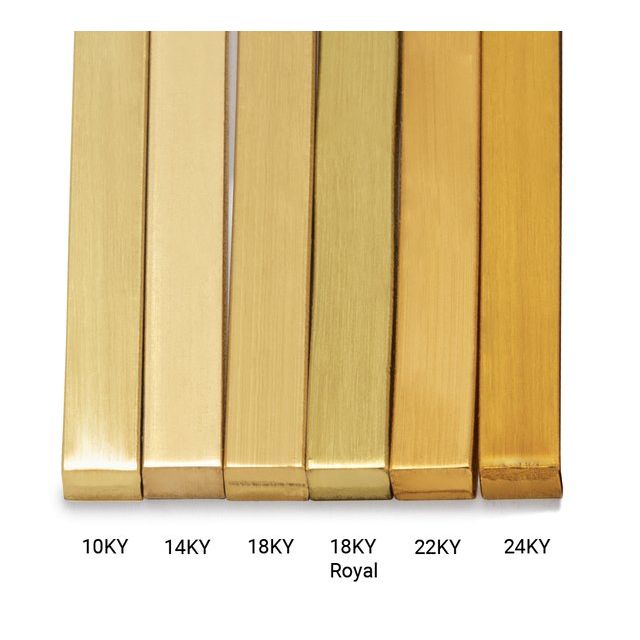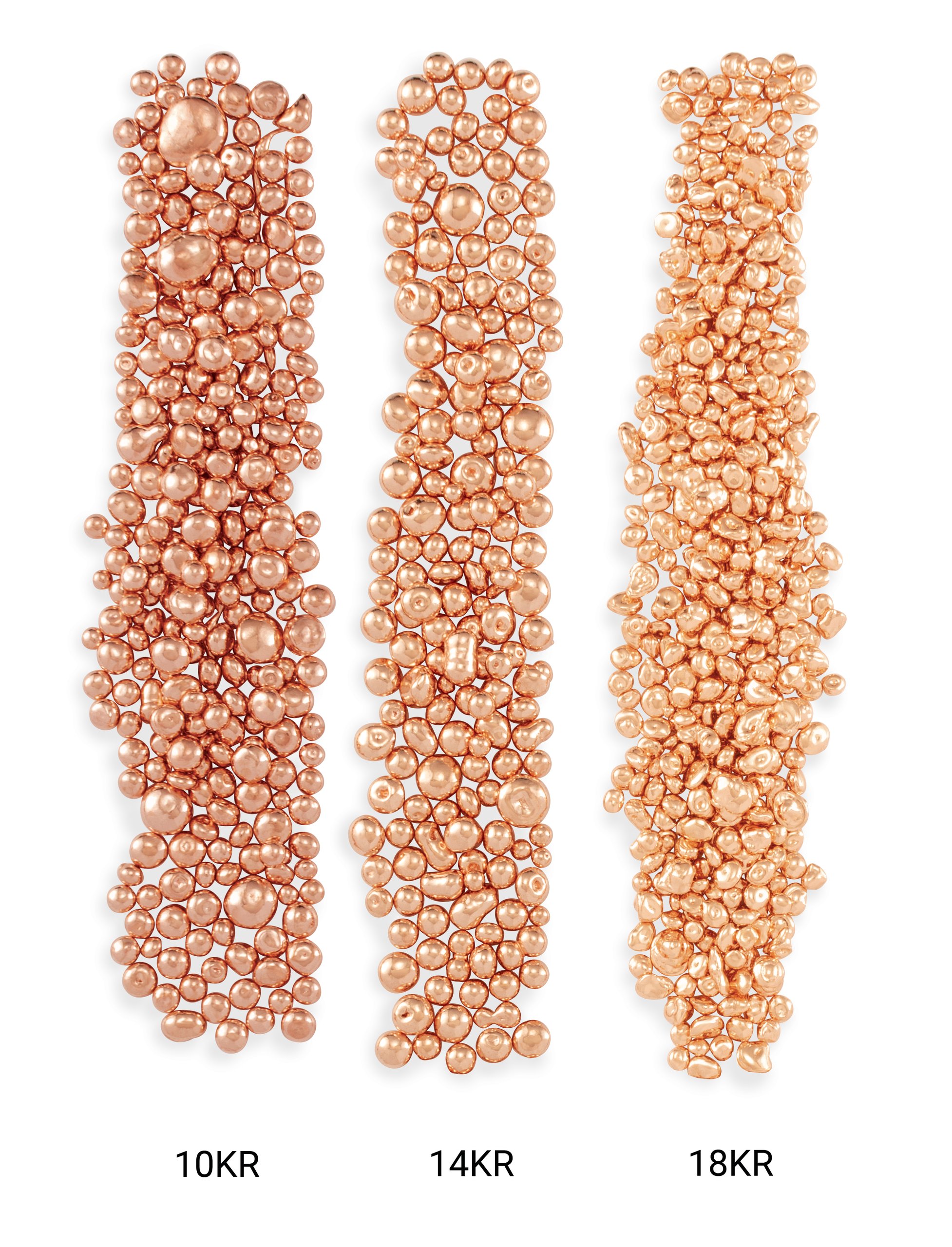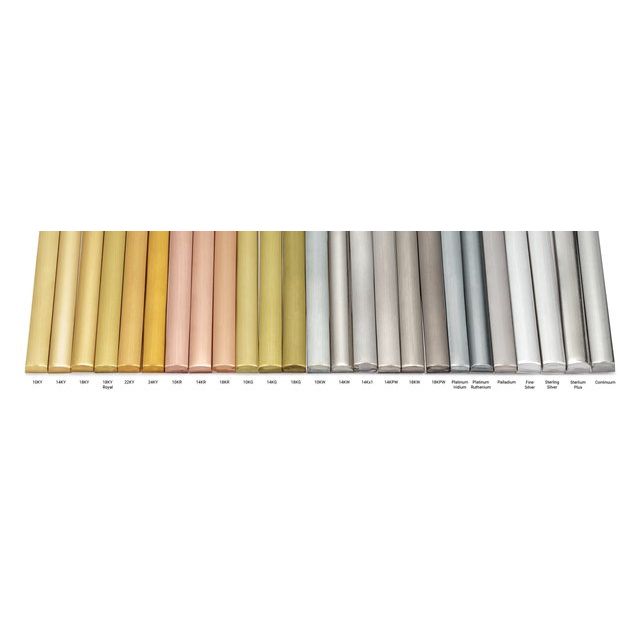Precious Metal Descriptions

Sterling Silver
Sterling silver is the whitest precious metal. But it's rather soft, scratches easily and can develop a dark tarnish over time. I don't recommend it for engagement or more delicate wedding rings. Sterling silver is 92.5% Silver and 7.5% other metals, mostly copper.
- Pros: inexpensive, very white
- Cons: very soft, not durable to withstand daily wear and tear, tarnishes easily

Platinum
- Platinum is a naturally white metal that will not tarnish in air.
- It does not require rhodium plating to maintain its whiteness.
- Platinum is considered being Hypoallergenic, the perfect choice for those with sensitive skin.
- It has a greater wear resistance compared with white gold in terms of metal loss and is very durable. Platinum jewelry will weigh the same in 50 years as it does today - meaning your platinum ring could be worn by generations! It's ideal for heirloom jewelry.
- Being one of the densest elements on earth, rings in platinum are heavier than gold or palladium rings.
- All precious metals will scratch, however, when platinum scratches, it tends to displace rather than lose metal weight. It will develop a patina like appearance with wear and can easily be re-polished to it's original shine. Your platinum jewelry will outlast other precious metal jewelry and hold stones in place more securely.
- Platinum is the rarest precious metal, embodying timeless beauty and individuality.

The most common platinum alloy I use contains 95% Platinum and 5% Ruthenium or Cobalt.
- Pros: very pure, hypo-allergenic, does not tarnish or react to most household chemicals or chlorine, much whiter than white gold alloys and no yellowing, does not wear down like white gold, best for stone settings
- Cons: slightly softer and scratches easier than white gold alloys, very heavy, more expensive than 14k gold
White Gold Alloys
White gold is an alloy created by mixing pure yellow gold with other metals to strengthen and whiten it. The most common white gold alloy in the US is alloyed with nickel and zinc.
White gold comes in different karats from 10-22, with 14k being the most commonly used, 10k and 18k are used to an lesser extend. 14k white gold is made up of 58.3% fine gold and 41.7% other metals, 18k gold is made up of 75% fine gold and the rest other metals.
There are also white gold alloys that are nickel free to cater to those with nickel allergies. These gold alloys use palladium instead of nickel. But since palladium is far more expensive than nickel, these alloys will always cost more. They are only being offered as custom metal options on my site. The standard white gold option being offerred is a 14k nickel containing white gold alloy.

Various white gold alloys
Please note that in all white gold alloys there will be slight variations in color hues depending on which metal supplier or which fabrication method and corresponding alloy was used. There is just no standard recipe for white gold alloys.
14k Nickel White Gold (standard) vs 18k Nickel White Gold
In these white gold alloys nickel is used instead of palladium to whiten the gold. Most white gold jewelry made in the US has some nickel in it. About 15% of the population is allergic to nickel. Nickel white gold alloys are less expensive than palladium white gold alloys.
- 14k white gold is made up of 58.3% fine gold and 41.7% other metals, 18k gold is made up of 75% fine gold and the rest other metals. The other metals are usually nickel, zinc, silver, and copper.
- 18k white gold is purer and has a higher content of non reactive / non tarnishing metals, so it's less likely to discolor or cause allergies than 14k gold. 18k white gold is a bit heavier than 14k white gold and more expensive. All gold alloys react to chlorine in water and can get damaged and porous over time and with long exposure.
- As with all gold alloys there are variations in color hue even with the same purity depending on exact alloy composition. Some are more yellow than others. I can't guarantee your wedding ring and engagement ring will match exactly if not ordered at the same time.
>>> Please note that I do not offer rhodium plating of white gold alloys. The nickel or palladium white gold is grayer than rhodium plated white gold. It will not match in color if you are intending to wear it next to plated white gold rings. However, you can get your palladium white gold or nickel white gold rings plated at a local jeweler who offers plating services. Plating wears down over time and has to be redone every 6 month to 1-2 years depending on wear. Frequent replating will wear down jewelry over time as the old plating needs to be removed, then repolish the rings out fully and then replate. During the repolishing of all the surfaces the wear is affected. It removes fine details, wears down prongs, textures, engravings and softens crisp edges.

14K Palladium White Gold/ 18K Palladium White Gold (custom orders only)
- Nickel free white gold that does not need rhodium plating. No rhodium plating means lower maintenance. It has a warm gray hue (it will not match your rhodium plated white gold jewelry).
- Palladium white gold is an alternative for people being allergic to standard nickel white golds.
- 18kPDW is slightly brighter in color than 14kPDW and also a bit harder and more scratch resistant than 14k palladium white gold, platinum or palladium.
- 14k white gold is made up of 58.3% fine gold and 41.7% other metals, 18k gold is made up of 75% fine gold and the rest other metals. The other metals are usually silver, copper and palladium.
- 18k white gold is purer and has a higher content of non reactive / non tarnishing metals, so it's less likely to discolor or cause allergies than 14k gold. 18k white gold is a bit heavier than 14k white gold and more expensive. All gold alloys react to chlorine in water and can get damaged and porous over time and with long exposure.
- As with all gold alloys there are variations in color hue even with the same purity depending on exact alloy composition. Some are more yellow than others. I can't guarantee your wedding ring and engagement ring will match exactly if not ordered at the same time.
14k Palladium White Gold
- Pros: slightly harder than palladium or platinum, less expensive than 18k palladium White Gold or Platinum
- Cons: warm gray color, darker than other white metals, not very pure, more likely to react (tarnish/discolor/be allergenic) than 18k Palladium White Gold, Palladium or Platinum
18k Palladium White Gold
- Pros: harder and more scratch resistant than palladium, platinum or 14k Palladium White Gold, less expensive than Platinum, slightly whiter than 14k Palladium White Gold, less likely to react (tarnish/discolor/be allergenic) than 14k Palladium White Gold
- Cons: warm gray color, more likely to react (tarnish/discolor/be allergenic) than Palladium or Platinum
Some designs are not available in both palladium white gold options. Due to the rising cost of palladium on the metal markets I am offering my designs in standard nickel containing white gold alloys and if available in an ultra-white high nickel content white gold alloy. Palladium white gold alloys are only ofered as custom orders.
All these rings were not rhodium plated.

White Gold (14kPDW) vs Sterling Silver set with a white lab created sapphire
14k Yellow Gold/ 18k Yellow Gold
Classic yellow gold that provides durability and timeless appeal. 14k yellow old is the most common yellow gold alloy used in the US due to it's prefect blend of affordability and strength. 14k gold is made up of 58.3% fine gold and 41.7% other metals, 18k gold is made up of 75% fine gold and the rest other metals. 14k has a medium yellow color - not as rich yellow as 18k yellow gold with it's higher gold content. The other metals are copper, silver and possibly a tiny amount of zinc and possibly silicone. There is no nickel in these alloys.

18k gold is purer and has a higher content of non reactive / non tarnishing metals, so it's less likely to discolor or cause allergies than 14k gold. 18k gold is a bit heavier than 14k gold and more expensive. For some design 10k yellow gold is and option or can be used for custom orders. All gold alloys react to chlorine in water and can get damaged over time and with long exposure. Most 14k yellow gold alloys are a bit harder and more scratch resistant than 18k yellow gold alloys.
Various yellow gold alloys that show how different the color (and physical properties) can be within the same karat.
As with all gold alloys there are variations in color hue even with the same purity depending on exact alloy composition. I can't guarantee your wedding ring and engagement ring will match exactly if not ordered at the same time.

Rose Gold
This gold alloy has a high copper content to give the metal it's warm red color hue. Actual color may vary depending on exact alloy composition and can range from a peach color to a coppery rose color. 14k rose gold is made up of 58.3% fine gold and 41.7% other metals. Those other metals are copper, silver, zinc and silicone. There is a high copper content in rose gold which may cause allergies for people with copper allergies. It's also more likely to tarnish/ discolor or react to household chemicals. All gold alloys react to chlorine in water and can get damaged over time and with long exposure. 14k rose gold is softer than white gold and some yellow gold alloys.
10k and 18k rose gold are available as custom orders for some design. 10k rose gold tends to look slightly more copper color than 14kR and 18k rose gold has a more peach color.


Palladium 950PD (discontinued)
Please note: Global supply pressure has significantly increased palladium markets and acquisition costs. We recommend platinum as an alternative option and are phasing out palladium for our made to order jewelry. Or go with a 14k nickel white gold alloy for a lower cost option if there are no known nickel allergies.
Palladium is naturally white metal and will not tarnish. Like platinum, palladium does not require rhodium plating and will maintain its bright white color indefinitely. Palladium rarely causes allergic reaction. It is very durable and even outlasts white gold. It is a great choice for engagement or wedding rings. The alloy used contains 95% Palladium and either 5% Ruthenium or 5% Gallium. There is no copper and no nickel in this alloy and therefore a great metal for people with nickel or copper allergies.
- Pros: very pure, hypo-allergenic, does not tarnish or react to most household chemicals or chlorine, whiter than white gold alloys and no yellowing, many of the platinum properties, much lighter than platinum, does not wear down like white gold
- Cons: slightly softer and scratches easier than white gold alloys, may be harder to find a repair jeweler in rural US areas or internationally, but should not be a problem in most US cities

Precious Metal Comparison
|
Metal
|
Composition/
Weight (Specific Gravity)
|
Hardness /
Wear Resistance
|
Color
|
Allergies, Resistance to discoloration/ tarnish/ chemicals
|
Maintenance
|
|
Sterling Silver
|
92.5% Pure
92.5% Silver, 7.5% Others (mostly copper but can have minor palladium, germanium, silicone)
Specific Gravity: 10.2, very light
|
75-80 HV as-cast
Soft and scratches easily
Low wear resistance, thins due to wear
|
Whitest metal but can tarnish easily
|
Tarnishes easily in air and if exposed to household chemicals. Nickel free.
|
Frequent repolishing required, Scratches may be too deep to get them removed through polishing
|
|
Palladium
|
95% Pure
95% Palladium, 5% Others (Ruthenium or Gallium)
Specific Gravity: 11.8
Similar in weight to 14k yellow gold,
55-60% lighter than platinum
|
125-138 HV as-cast
Slightly softer than palladium white gold alloys
It does not wear down or thin over time as much as white gold.
15% greater wear resistance compared with white gold in terms of metal loss/thinning due to wear.
|
Maintains it's white color forever. The color is a neutral gray. Darker than Sterling Silver or rhodium plated white gold. But lighter than non-plated palladium white gold. Very close to the color of platinum.
|
Nickel and copper free. Generally Hypo-allergenic
Extreme tarnish resistance, not likely to be affected (discolored or corroded) by household chemicals or chlorine
|
Long term maintenance includes repolishing. Polishing palladium is more labor intensive than gold, but not as much as platinum
Most scratches are not deep and can be easily be polished out by a jeweler.
|
|
Platinum
|
95% Pure
95% Platinum, 5% others (mostly Ruthenium)
Specific Gravity: 20.7
75-80% heavier than white gold, platinum is the densest metal alloy
|
130 HV as-cast
Slightly softer than palladium white gold alloys
It does not wear down or thin over time as much as white gold.
23% greater wear resistance compared with white gold in terms of metal loss/thinning due to wear.
Because of it’s high density it holds textures, patterns and engravings better than other alloys and often edges look sharper
|
Maintains it's white color forever. The color is a neutral light gray. Darker than Sterling Silver or rhodium plated white gold. A tad lighter than palladium. Much lighter than non-plated palladium White Gold.
|
Nickel and copper free. Hypo-allergenic
Extreme tarnish resistance, least likely to be affected (discolored or corroded) by household chemicals or chlorine
.
|
Long term maintenance includes repolishing. Polishing platinum is more labor intensive than gold or palladium alloys.
Most scratches are not deep and can be easily be polished out by a jeweler.
|
|
14k Palladium White Gold
|
58.3% gold, 41.7% Other (copper, silver, palladium),
Nickel-free
Specific Gravity: 14.6
Slightly heavier than palladium but only 30% lighter than platinum
|
125 -140 HV as-cast (palladium white gold)
Usually stiffer and slightly harder than palladium or platinum with slightly better scratch resistance.
Metal does wear down over the years more than platinum or palladium.
|
Warm gray color, darker than palladium or platinum with a yellow tint to it. Actual color may vary depending on exact alloy composition.
Does not yellow over time as much as nickel based white gold alloys.
Does not need rhodium plating, but plating can be done at a jeweler if a whiter color is desired.
|
Nickel free. Lower gold purity than 18k white gold and more likely to cause allergies, tarnish or discolor than 18k white gold, palladium or platinum.
Can be damaged (get brittle and porous) if exposed to chlorine and household chemicals.
|
Long term maintenance includes repolishing.
Most scratches are not deep and can be easily be polished out.
Does not require rhodium plating, but if plating was done it does need to be refreshed every couple of months/years depending on wear
|
|
18k Palladium White Gold
|
75.2% gold, 24.8% Other (copper, palladium),
Nickel-free
Specific Gravity: 15.9
10-20% heavier than 14k gold, 20-25% lighter than platinum
|
130 -158 HV as-cast (palladium white gold)
Usually a tad stiffer and slightly harder than palladium or platinum with slightly better scratch resistance. Slightly harder and more scratch resistant than 14k palladium white gold.
Metal does wear down over the years more than platinum or palladium.
|
Warm gray color, darker than palladium or platinum with a yellow tint to it. Often a tad brighter than 14k palladium alloy. Actual color may vary depending on exact alloy composition and alloy manufacturer.
Does not yellow over time as much as nickel based white gold alloys.
Does not need rhodium plating, but plating can be done at a local jeweler if a whiter color is desired.
|
Nickel free. Purer than 14k white gold but not as pure as palladium or platinum. Less likely to cause allergies, tarnish or discolor than 14k white gold (more likely to react than palladium or platinum)
Can be damaged (get brittle and porous) if exposed to chlorine.
|
Long term maintenance includes repolishing.
Most scratches are not deep and can be easily be polished out.
Does not require rhodium plating, but if plating was done it does need to be refreshed every couple of months/years depending on wear
|
|
14k Yellow Gold
|
58.3% gold, 41.7% Other (copper, silver, zinc, silicone)
Nickel-free
Specific Gravity: 13
Lighter than 18k yellow gold.
|
134 - 140 HV as-cast
Harder than 18k yellow gold or 14k rose gold.
Metal does wear down over the years.
|
Paler and often slightly warmer in color than 18k yellow gold.
Actual color may vary depending on exact alloy composition and alloy manufacturer.
|
Nickel free. Lower gold purity than 18k yellow gold and more likely to cause allergies, tarnish or discolor than 18k yellow gold.
Can be damaged (get brittle and porous) if exposed to chlorine and household chemicals.
|
Long term maintenance includes repolishing
|
|
18k Yellow Gold
|
75.2% gold, 24.8% Other (copper, silver, zinc, silicone)
Nickel-free
Specific Gravity: 15.6
Heavier than 14k yellow gold.
|
125 to 135 HV as-cast
Slightly softer than 14k yellow gold.
Metal does wear down over the years.
|
More intense yellow than 14k yellow gold.
Actual color may vary depending on exact alloy composition and alloy manufacturer.
|
Purer than 14k white gold. Less likely to cause allergies, tarnish or discolor than 14k yellow gold.
Can be damaged (get brittle and porous) if exposed to chlorine.
|
Long term maintenance includes repolishing
|
|
14k Rose Gold
|
58.3% gold, 41.7% Other (copper, silver, zinc, silicone)
Nickel-free
Specific Gravity: 13
|
88-130 HV as-cast
Softer than 14k yellow gold.
Metal does wear down over the years.
|
Coppery color which can be peachy or more rosy.
Actual color may vary depending on exact alloy composition and alloy manufacturer.
|
Nickel free. But high copper content (which can cause copper allergies). More likely to tarnish or discolor than 14k yellow gold.
Can be damaged (get brittle and porous) if exposed to chlorine
|
Long term maintenance includes repolishing
|
Rhodium Plating
Rhodium plating is a very thin layer of metal plating over white gold, 800 HV Vickers Hardness, very hard but wears off quickly (within 6 month to 2 years depending on wear and body chemistry), makes white gold more scratch resistant for a short time, adds maintenance cost to redo plating frequently, plating has be redone if ring gets sized or repaired. Rhodium plating is not offered by Nodeform.

Silver/Palladium (discontinued)
Silver/Palladium alloy (AGPD) contains approximately 54% silver, 25% Palladium, and 21% Copper. Its hardness falls right in between that of 14KY and 14KW golds. In addition to increased durability it provides better tarnish resistance than normal Sterling Silver. It's color is very similar to palladium (950PD) with a warm hint, a bit greyer than sterling silver. It's an economical choice if Palladium or white gold are not in someone's budget. But since it is a custom alloy, it could be challenging to get any future repair or sizing work done at your local jeweler. I discontinued this metal option as I won't be able to cast it anymore due to health concerns related to the lost-wax-casting procedure.
I won't be offering it anymore for any made to order ring. It was a metal I had to cast in my own studio and I won't be able to do that anymore due to ventilation issues and health concerns. If you got previously an engagement ring from me in the silver/palladium alloy, I recommend to choose a 14k Palladium white gold wedding band to match it. The metal looks pretty much the same and it will wear similar. So there are no issues wearing these 2 different metals next to each other. They are similar in hardness too and both nickel-free.
More detailed information about the all the alloys and pictures are available in this blog post.
Recycled Metal
All precious metals I use are recycled.
I do send out all my casting at this time. All those casters do use recycled metals.
For platinum and palladium I use Techform as my preferred caster as they provide the best quality and service I have seen so far from commercial casters. Unfortunately they don't cast any white gold or silver, I use a Quality Casing in NY for that. The metal for some of my wedding bands occasionally comes from Hoover & Strong.
For the metals I can cast or melt down for fabrication, I recycle some of my own old metals. Typically a mix of max 50% old and min 50% new metal is required to avoid issues.
I do buy most of my new recycled casting grain and mill products like wire and stock from well respected trade suppliers such as Hoover and Strong, Stuller or my local supplier in Los Angeles, D. H Fell. They also do my metal refining for scraps I can't reuse directly. All metals in my designs including the one's from the offsite casters are recycled and refined.
Metal Allergies
The precious metals I use are usually nickel free unless it's specifically indicated in the listing to be used on some findings for white gold earrings and necklaces.
A few people seem to have allergic reactions to Sterling silver. This could be due to the copper content. My guess is also that some actually are allergic to plated silver. My designs are never plated, but some commercial jewelry gets plated with rhodium to prevent it from tarnishing. As I understand it, to plate silver it needs to be plated with nickle first and then with rhodium. Once the rhodium wears off, it exposes the nickle layer underneath which causes allergies.
Some are also allergic to yellow golds as those contain copper too. Basically any metal when constantly worn can cause an allergic reaction. If allergies are a concern, the best (but most expensive) choice is using platinum, followed by palladium and nickel free high karat (18K) gold alloys (palladium white gold or yellow gold).
Metal allergies are complex and it's often hard to really be able to pin point which of the ingredients in an alloy causes the reactions. Keeping jewelry clean is crucial to avoid skin reactions. Sometimes trapped soap residue is actually the cause for rashes and not the metal. If someone experiences allergic reactions, it is best to consult with a medical specialist and get an allergy test done.
Other Metals
I don't use copper, bronze or brass for my rings. I can't currently work with Titanium or Steel. They require some totally different tools and techniques.

























